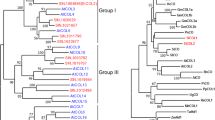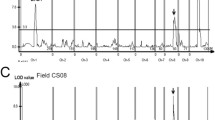Abstract
Sesame (Sesamum indicum L.) is an oilseed crop with high concentration of unsaturated fatty acids. It is produced in many developing countries of the tropical and subtropical regions. Despite its economic and social importance, limited genetic analyses were conducted on sesame to improve its yield. One of the yield-related traits is flowering time, which is crucial for the adaptation of crops to local environments and changing climatic conditions. To gain further insights into the molecular mechanisms behind the control of flowering in sesame, we searched homologs of FLOWERING LOCUS T (FT) and circadian clock-associated genes in the sesame genome. Then we compared their expression between early- and late-flowering sesame varieties before (10 days post-emergence [dpe]), around (20 dpe), and after flowering (30 dpe). Four copies of FT-like genes were found in sesame: SiFTL1/SiFT was up-regulated at 20 and 30 dpe and SiFTL2 at 30 dpe. SiFTL3 was poorly expressed throughout the three stages, and SiFTL4 was highly expressed at 10 dpe but not at later stages. These results suggest that SiFTL1/SiFT acts as florigen, and SiFTL4 could be a floral repressor. The CONSTANS-like genes SiCOL1 and SiCOL2 were highly expressed at 20 dpe suggesting its role as an inducer of florigen. In addition, the early-flowering sesame variety presented higher expression of SiFTL1/SiFT, SiFTL2, and SiCOL2 than the late-flowering variety at 20 dpe. The expression of SiGIs and circadian clock-related genes were similar between the two varieties. Our results suggest that SiCOLs or their regulator might be the causal gene for flowering time variation between the two sesame varieties studied.





Similar content being viewed by others
References
Abebe TN (2016) Review of sesame value chain in ethiopia. Int J Afr Asian Stud 19:36–47
Cao D, Li Y, Lu S et al (2015) GmCOL1a and GmCOL1b function as flowering repressors in soybean under long-day conditions. Plant Cell Physiol 56:2409–2422. https://doi.org/10.1093/PCP/PCV152
Fornara F, Panigrahi KCS, Gissot L et al (2009) Arabidopsis DOF transcription factors act redundantly to reduce CONSTANS expression and are essential for a photoperiodic flowering response. Dev Cell 17:75–86. https://doi.org/10.1016/J.DEVCEL.2009.06.015
Fowler S, Lee K, Onouchi H et al (1999) GIGANTEA: a circadian clock-controlled gene that regulates photoperiodic flowering in Arabidopsis and encodes a protein with several possible membrane-spanning domains. EMBO J 18:4679–4688. https://doi.org/10.1093/emboj/18.17.4679
Hayama R, Izawa T, Shimamoto K (2002) Isolation of Rice Genes Possibly Involved in the Photoperiodic Control of Flowering by a Fluorescent Differential Display Method. Plant Cell Physiol 43:494–504. https://doi.org/10.1093/pcp/pcf059
Hayama R, Yokoi S, Tamaki S et al (2003) Adaptation of photoperiodic control pathways produces short-day flowering in rice. Nature 422(6933):719–722. https://doi.org/10.1038/nature01549
Hecht V, Knowles CL, Vander Schoor JK et al (2007) Pea LATE BLOOMER1 is a GIGANTEA Ortholog with roles in photoperiodic flowering, deetiolation, and transcriptional regulation of circadian clock gene homologs. Plant Physiol 144:648–661. https://doi.org/10.1104/PP.107.096818
Higuchi Y, Sage-Ono K, Sasaki R et al (2011) Constitutive expression of the GIGANTEA Ortholog Affects Circadian Rhythms and Suppresses One-shot Induction of Flowering in Pharbitis nil a Typical Short-day Plant. Plant Cell Physiol 52:638–650. https://doi.org/10.1093/pcp/pcr023
Izawa T, Oikawa T, Sugiyama N et al (2002) Phytochrome mediates the external light signal to repress FT orthologs in photoperiodic flowering of rice. Genes Dev 16:2006–2020. https://doi.org/10.1101/GAD.999202
Jang S, Torti S, Coupland G (2009) Genetic and spatial interactions between FT, TSF and SVP during the early stages of floral induction in Arabidopsis. Plant J 60:614–625. https://doi.org/10.1111/J.1365-313X.2009.03986.X
Jiang B, Zhang S, Song W et al (2019) Natural variations of FT family genes in soybean varieties covering a wide range of maturity groups. BMC Genom 20:230. https://doi.org/10.1186/S12864-019-5577-5
Jung C, Müller AE (2009) Flowering time control and applications in plant breeding. Trends Plant Sci 14:563–573. https://doi.org/10.1016/J.TPLANTS.2009.07.005
Katoh K, Standley DM (2013) MAFFT multiple sequence alignment software version 7: improvements in performance and usability. Mol Biol Evol 30:772–780. https://doi.org/10.1093/MOLBEV/MST010
Kong F, Liu B, Xia Z et al (2010) Two coordinately regulated homologs of FLOWERING LOCUS T are involved in the control of photoperiodic flowering in soybean. Plant Physiol 154:1220–1231. https://doi.org/10.1104/PP.110.160796
Liu W, Jiang B, Ma L et al (2018) Functional diversification of flowering locus t homologs in soybean: GmFT1a and GmFT2a/5a have opposite roles in controlling flowering and maturation. New Phytol 217:1335–1345. https://doi.org/10.1111/NPH.14884
Madeira F, Pearce M, Tivey ARN et al (2022) Search and sequence analysis tools services from EMBL-EBI in 2022. Nucleic Acids Res 50:W276–W279. https://doi.org/10.1093/NAR/GKAC240
Mathieu J, Warthmann N, Küttner F, Schmid M (2007) Export of FT protein from phloem companion cells is sufficient for floral induction in Arabidopsis. Curr Biol 17:1055–1060. https://doi.org/10.1016/j.cub.2007.05.009
Matsushika A, Makino S, Kojima M, Mizuno T (2000) Circadian waves of expression of the APRR1/TOC1 family of pseudo-response regulators in Arabidopsis thaliana: insight into the plant circadian clock. Plant Cell Physiol 41:1002–1012. https://doi.org/10.1093/PCP/PCD043
Myint D, Gilani SA, Kawase M, Watanabe KN (2020) Sustainable sesame (Sesamumindicum L.) production through improved technology: an overview of production, challenges, and opportunities in myanmar. Sustainability 12:3515. https://doi.org/10.3390/SU12093515
Nakamichi N (2015) Adaptation to the local environment by modifications of the photoperiod response in crops. Plant Cell Physiol 56:594–604. https://doi.org/10.1093/PCP/PCU181
Nakamichi N, Kiba T, Henriques R et al (2010) Pseudo-response regulators 9, 7, and 5 are transcriptional repressors in the Arabidopsis circadian clock. Plant Cell 22:594–605. https://doi.org/10.1105/TPC.109.072892
Namiki M (2007) Nutraceutical functions of sesame: a review. Crit Rev Food Sci Nutr 47:651–673. https://doi.org/10.1080/10408390600919114
Nan H, Cao D, Zhang D et al (2014) GmFT2a and GmFT5a redundantly and differentially regulate flowering through Interaction with and upregulation of the bZIP transcription factor GmFDL19 in soybean. PLoS One 9:e97669. https://doi.org/10.1371/JOURNAL.PONE.0097669
Suddihiyam P, Steer BT, Turner DW (1992) The flowering of sesame (Sesamum indicum L.) in response to temperature and photoperiod. Aust J Agric Res 43:1101–1116. https://doi.org/10.1071/AR9921101
Sun C, He C, Zhong C et al (2022) Bifunctional regulators of photoperiodic flowering in short day plant rice. Front Plant Sci 13:1044790. https://doi.org/10.3389/FPLS.2022.1044790
Takata N, Saito S, Saito CT, Uemura M (2010) Phylogenetic footprint of the plant clock system in angiosperms: evolutionary processes of pseudo-response regulators. BMC Evol Biol 10:126. https://doi.org/10.1186/1471-2148-10-126
Tamura K, Stecher G, Kumar S (2021) MEGA11: molecular evolutionary genetics analysis version 11. Mol Biol Evol 38:3022–3027. https://doi.org/10.1093/MOLBEV/MSAB120
Teklu DH, Shimelis H, Abady S (2022) Genetic improvement in sesame (Sesamum indicum L.): progress and outlook: a review. Agronomy 12:2144. https://doi.org/10.3390/AGRONOMY12092144
Uzun B, Arslan Ç, Furat Ş (2008) Variation in fatty acid compositions, oil content and oil yield in a germplasm collection of sesame (Sesamum indicum L). J Am Oil Chem Soc 85:1135–1142. https://doi.org/10.1007/S11746-008-1304-0
Wang L, Yu S, Tong C et al (2014) Genome sequencing of the high oil crop sesame provides insight into oil biosynthesis. Genome Biol 15:R39. https://doi.org/10.1186/GB-2014-15-2-R39
Wang M, Huang J, Liu S et al (2022) Improved assembly and annotation of the sesame genome. DNA Res 29:dsac041. https://doi.org/10.1093/DNARES/DSAC041
Wang P, Wang L, Zhang L et al (2022) Genomic dissection and diurnal expression analysis reveal the essential roles of the PRR gene family in geographical adaptation of soybean. Int J Mol Sci 23:9970. https://doi.org/10.3390/IJMS23179970
Wang F, Li S, Kong F et al (2023) Altered regulation of flowering expands growth ranges and maximizes yields in major crops. Front Plant Sci 14:47. https://doi.org/10.3389/FPLS.2023.1094411
Watanabe S, Xia Z, Hideshima R et al (2011) A map-based cloning strategy employing a residual heterozygous line reveals that the GIGANTEA Gene is involved in soybean maturity and flowering. Genetics 188:395–407. https://doi.org/10.1534/GENETICS.110.125062
Wei L, Miao H, Zhao R et al (2013) Identification and testing of reference genes for sesame gene expression analysis by quantitative real-time PCR. Planta 237:873–889. https://doi.org/10.1007/s00425-012-1805-9
Wu F, Kang X, Wang M et al (2019) Transcriptome-enabled network inference revealed the GmCOL1 feed-forward loop and its roles in photoperiodic flowering of soybean. Front Plant Sci 10:1221. https://doi.org/10.3389/FPLS.2019.01221
Yamaguchi A, Kobayashi Y, Goto K et al (2005) Twin sister of FT (TSF) acts as a floral pathway integrator redundantly with FT. Plant Cell Physiol 46:1175–1189. https://doi.org/10.1093/PCP/PCI151
Yano M, Katayose Y, Ashikari M et al (2000) Hd1, a major photoperiod sensitivity quantitative trait Locus in Rice, is closely related to the Arabidopsis flowering time gene CONSTANS. Plant Cell 12:2473–2483. https://doi.org/10.1105/TPC.12.12.2473
Zhai H, Lü S, Liang S et al (2014) GmFT4, a homolog of FLOWERING LOCUS T, is positively regulated by E1 and functions as a flowering repressor in soybean. PLoS One 9:e89030. https://doi.org/10.1371/JOURNAL.PONE.0089030
Zhang H, Miao H, Wang L et al (2013) Genome sequencing of the important oilseed crop Sesamum indicum L. Genome Biol 14:401. https://doi.org/10.1186/GB-2013-14-1-401
Zhao J, Huang X, Ouyang X et al (2012) OsELF3-1, an ortholog of Arabidopsis EARLY FLOWERING 3, regulates rice circadian rhythm and photoperiodic flowering. PLoS One 7:e43705. https://doi.org/10.1371/JOURNAL.PONE.0043705
Zhou R, Liu P, Li D et al (2018) Photoperiod response-related gene SiCOL1 contributes to flowering in sesame. BMC Plant Biol 18:343. https://doi.org/10.1186/S12870-018-1583-Z
Acknowledgements
We gratefully acknowledge Dr. Rosa Oviedo de Cristaldo for providing seeds of sesame genotypes. This work was partially supported by Consejo Nacional de Ciencia y Tecnología (CONACYT) from Paraguay Grant No. PINV15-315 to JCMI. The funders had no role in study design, data collection and analysis, decision to publish, or preparation of the manuscript.
Author information
Authors and Affiliations
Corresponding author
Ethics declarations
Conflict of interest
The authors declare that they have no conflict of interest.
Additional information
Publisher’s Note
Springer Nature remains neutral with regard to jurisdictional claims in published maps and institutional affiliations.
Supplementary Information
Below is the link to the electronic supplementary material.
Rights and permissions
Springer Nature or its licensor (e.g. a society or other partner) holds exclusive rights to this article under a publishing agreement with the author(s) or other rightsholder(s); author self-archiving of the accepted manuscript version of this article is solely governed by the terms of such publishing agreement and applicable law.
About this article
Cite this article
López, M., Larrea, H., Alvarenga, N. et al. CONSTANS-like genes are associated with flowering time in sesame. Theor. Exp. Plant Physiol. 35, 341–353 (2023). https://doi.org/10.1007/s40626-023-00290-4
Received:
Accepted:
Published:
Issue Date:
DOI: https://doi.org/10.1007/s40626-023-00290-4




